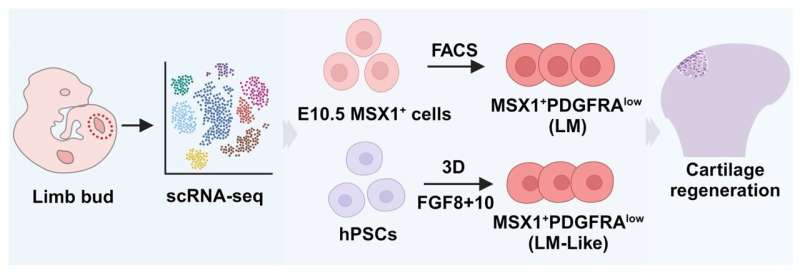This article has been reviewed according to Science X's editorial process and policies. Editors have highlighted the following attributes while ensuring the content's credibility:
fact-checked
peer-reviewed publication
proofread
New type of stem cell contains potential for knee cartilage regeneration in arthritic mice

Osteoarthritis (OA) is a debilitating joint disease which affects over 500 million people worldwide, with trends increasing as populations age. OA is caused by progressive, irreversible degeneration of joint cartilage, leading to pain, swelling and immobility in the affected joint. Current therapies focus on symptom relief but cannot restore degenerated cartilage.
A potential alternative treatment is the regeneration of cartilage from stem cells. Importantly, not all types of stem cells can make cartilage and earlier clinical trials with mesenchymal stem or stromal cells (MSCs) obtained did not convincingly show that MSCs make new cartilage when given to OA patients.
In search for the right type of stem cell for cartilage regeneration, Zhonghan Li and colleagues from Sichuan University, China, focused on so-called limb bud progenitor cells. The work was published in the journal Stem Cell Reports.
During vertebrate embryogenesis, limb bud progenitor cells give rise to limb cartilage, bone, and tendon, suggesting that this type of stem cell has a naturally high intrinsic capacity to make cartilage.
To test this hypothesis, the researchers used genetic tools to isolate limb bud progenitors from developing mouse embryos. Remarkably, after injection into knee joints of mice with OA, the limb bud progenitor cells efficiently generated new cartilage whereas MSCs given to a separate group of mice failed to do so.
Despite these encouraging results, limb bud progenitors are not readily obtainable from humans.
To overcome this, Li and colleagues turned towards human pluripotent stem cells (hPSCs), which are immature stem cells that can be grown to high numbers in the lab. After extensive protocol optimization, the researchers indeed obtained hPSCs-derived limb bud progenitors which closely resembled embryonic limb bud progenitors according to gene and protein expression.
Encouragingly, like their embryonic counterparts, hPSC-derived limb bud progenitors made new cartilage when transplanted into the knees of OA mice.
These findings set the stage for a potential cartilage replacement therapy for patients with OA, but further studies in animal models are required to confirm and replicate these findings. If such a treatment advances to the clinic it will need to pass proper regulatory review.
More information: MSX1+PDGFRAlow limb mesenchyme-like cells as an efficient stem cell source for human cartilage regeneration, Stem Cell Reports (2024). DOI: 10.1016/j.stemcr.2024.02.001. www.cell.com/stem-cell-reports … 2213-6711(24)00013-4




















